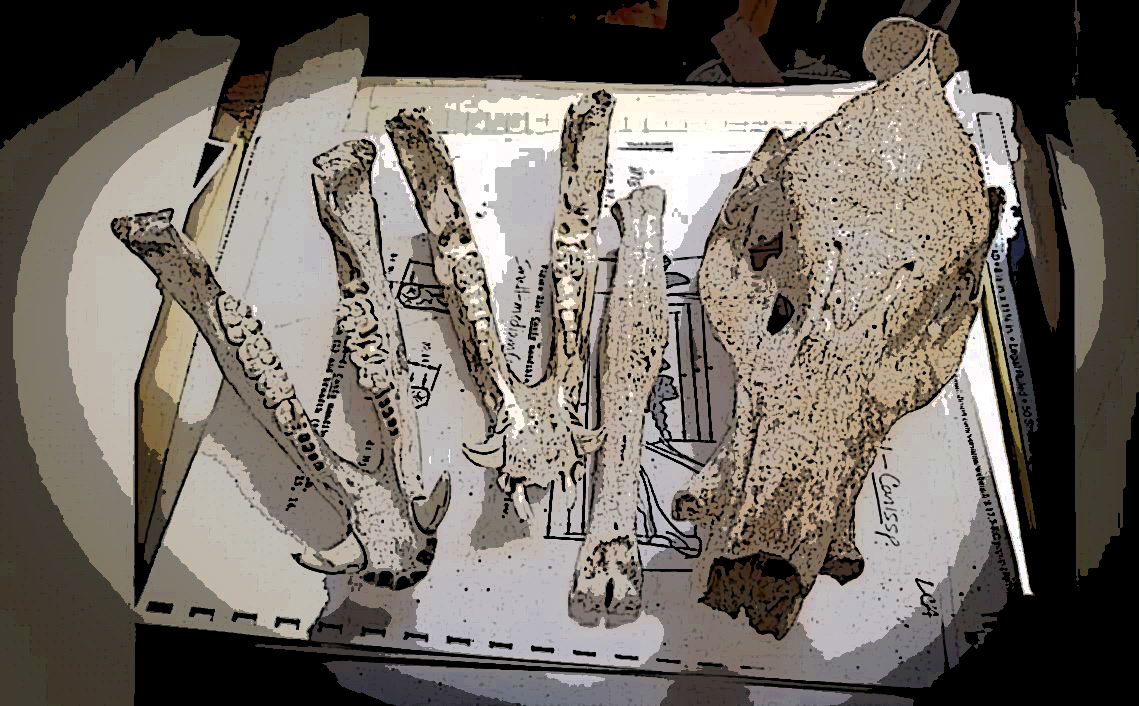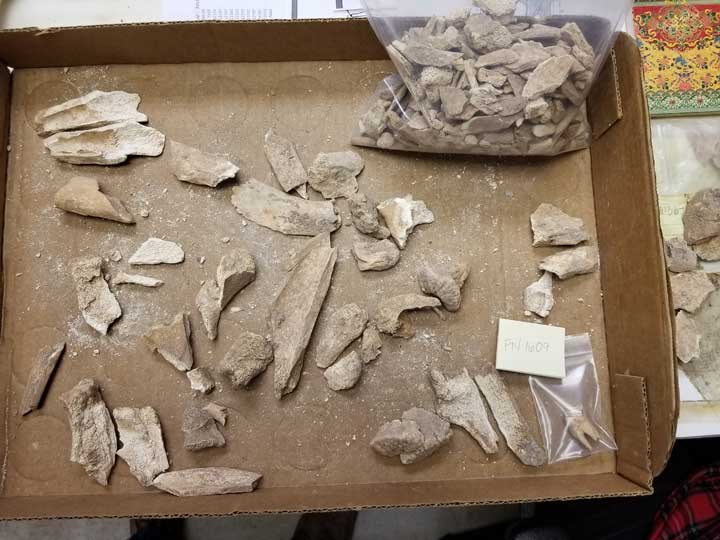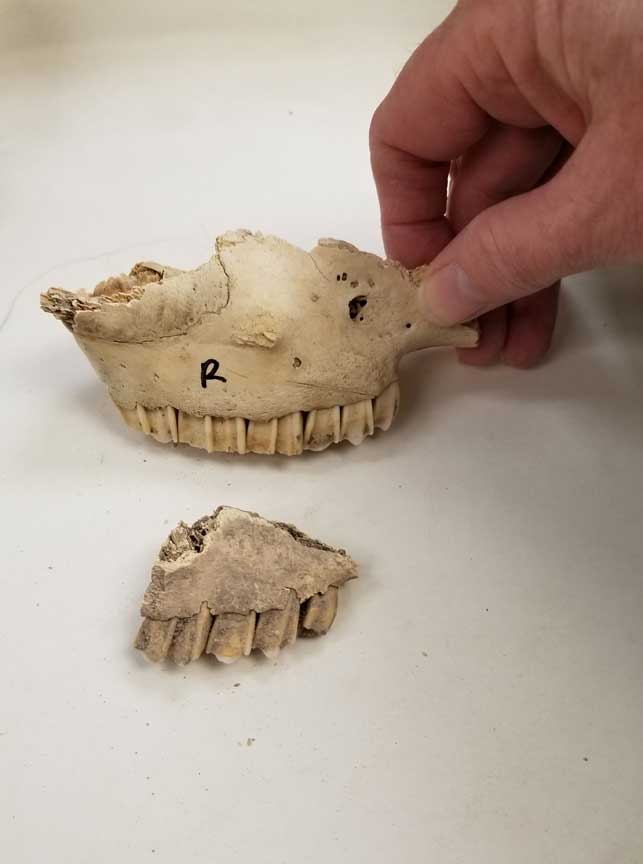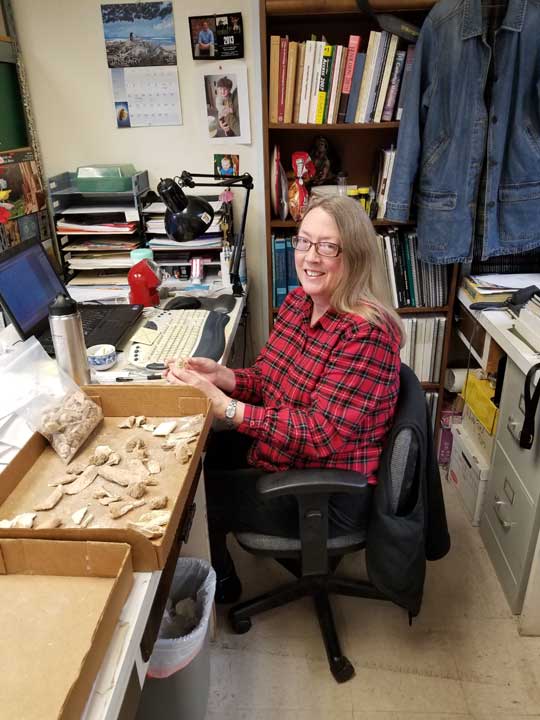
Meat: What’s for Breakfast, Lunch, and Supper!
Desert Archaeology zooarchaeologist Jenny Waters and historical archaeologist Homer Thiel talk about how archaeologists use animal bone to explore the meats eaten by people in the past.
There were probably few, if any, vegans or vegetarians in southern Arizona during the pre-contact, Spanish, Mexican, or American Territorial periods. People hunted or raised a variety of animals. We recover animal bones during our archaeological excavations. What can they tell us?
We formulate research questions prior to heading out to do an archaeological excavation. The questions related to dietary practices can include, “What was the environment like at the site?” “Were people hunting close to the site, or bringing animals from far away,” or “Did people in this household have better quality meats than their neighbors?” Desert Archaeology personnel have been analyzing faunal bone for decades, with Jenny Waters serving as the primary analyst since 1996.
Animal bones may be found either while digging or while screening. To ensure that small items aren’t missed during data recovery projects, we screen most of the dirt we excavate, typically through ¼-inch mesh. In some cases we use 1/8-inch mesh to recover a sample of smaller bones that usually fall through the ¼-inch mesh.
Bone preservation varies due to soil conditions. Few bones are found at sites with highly acidic soils. In other cases preservation is much better, especially at historic period sites. Once found, the bones are bagged, given a field number, and taken to the laboratory where they are dry-brushed or carefully washed in water. Preliminary counts are made, the bone is rebagged, and then boxed awaiting analysis.
Analysis starts by selecting sets of faunal bone that will provide information to answer the research questions. Once selected, individual bags are opened and the bones are laid out in trays.

A tray of animal bones recovered during excavations at the Historic Pima County Courthouse in downtown Tucson for the January 8th Memorial. The bones came from a thick layer of Presidio-era trash.
Jenny Waters then compares each bone to the skeletal elements in either Desert Archaeology’s comparative collection or the collection maintained at the Arizona State Museum, and records data for each bone fragment. The data can include the species, skeletal element, side of element, portion, age at death, degree of burning, type of butchering marks, and other bone surface modifications. In some cases she takes measurements or weighs the bone fragments.

Desert Archaeology has a comparative collection of commonly found species. Here, Jenny identifies a fragment of a maxilla from the Presidio dig by comparing it to a right sheep maxilla.
The most common species found at pre-contact sites in the Tucson Basin are jackrabbit and cottontail. These rabbits prefer different habitats. Jackrabbits like open ground, since they escape from predators by running away as fast as possible. Cottontails prefer to hide in grass or brush. If the percentage of jackrabbits is much higher than cottontails, this likely indicates that the area around a site had been denuded of vegetation, probably by people using it for firewood or building material. Larger amounts of cottontails may indicate lush vegetation, perhaps inside agricultural fields. Other rarer animals, including muskrats, fish, and some turtles are indicative of wetter environments.

Jenny identified this catfish bone by using a book containing photographs of catfish bones. While found in a Presidio-era trash layer, it is unlikely to date from that period, since catfish only arrived in the Santa Cruz River during the Territorial Period.
The types of deer, pronghorn antelope, or bighorn sheep bones present can indicate whether these species were hunted close to the habitation site or were brought in from far away. If hunted nearby, all portions of the skeleton are likely to be found, since the hunters could easily carry the entire carcass back home. If killed farther away, many of the bones would be discarded. The hunters often brought back smaller bones that were still attached to the animal hide, such as foot bones, as well as larger bones that could be turned into tools.
Father Eusebio Francisco Kino arrived in the late 1690s. He and other missionaries brought Old World domesticated animals into the Sonoran Desert: cattle, sheep, goats, pigs, chickens, horses, donkeys, and mules. Local Native Americans initially resisted becoming ranchers, but gradually took up animal husbandry and spent less time hunting wild game. The soldiers of the Presidio San Agustín del Tucson were required to have horses and mules, and were required to guard the King’s large cattle herd. The majority of bones found at the Presidio are from cattle, with smaller quantities of sheep and a much smaller number of pig and chicken.
Before animals could be eaten, they had to be butchered. Evidence for butchering often survives on bone. During pre-contact times, larger animals were broken down using stone knives, which sometimes left behind cut marks. Most bones were broken in order to extract marrow. During the Spanish and Mexican period, iron cleavers or axes were used to process animal carcasses. We find chop marks on bones, along with thinner blade marks that resulted from flesh being carved off. The bones themselves may have been smashed up into small pieces and tossed into boiling water to extract tallow (fat). This could be used as a food source or as a lubricant for axles and pulleys.
The American Territorial period, marking the transfer of control of Tucson from Mexico to the U.S., began in 1856. Trained butchers, including Samuel Hughes, brought new techniques, processing skeletal elements into individual cuts using hand saws and, eventually, mechanical saws. Some meat cuts were preferred over others, due to the type of meat and the quantity of fat present. Higher quality meats were more expensive and limited to people with higher incomes who could afford them. Poorer households ate less expensive meats.
Ethnic differences in meat preferences have also been identified. The Mexican population of Tucson often prepared menudo and other traditional dishes that incorporated carcass portions, such as cattle skulls and feet, that were usually not purchased by their European-American neighbors. Chinese residents often ate dried or preserved seafood, such as fish or cuttlefish. They also tended to eat a wider variety of meats than other Tucsonans.
Formal animal mortuary features are sometimes found during our work. At Early Agricultural period sites we have found small dogs, a juvenile bear, and possibly a hawk that were companion animals. Dogs continued to be raised through the Hohokam and Protohistoric eras. During the American Territorial period, dog, cat, and bird burials are frequently found in backyards, sometimes placed in boxes used for coffins.
Each archaeological project brings the opportunity to better understand the diet, environment, and companion animals of the people who once lived in Arizona. As we accumulate more and more information, we are starting to see broad trends in meat consumption.
Finally, a little-known fact: many faunal analysts are vegetarians!
Resources
See Jenny and Homer’s post about the staple protein of the prehistoric Tucson Basin.



